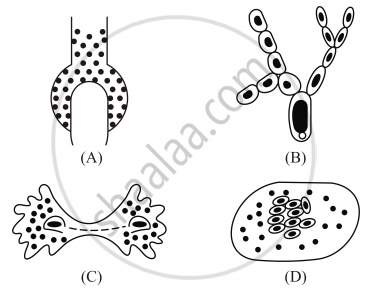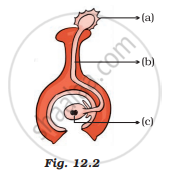Advertisements
Advertisements
प्रश्न
Define.
Fragmentation
उत्तर
The process of asexual reproduction in which the parent body breaks into many pieces or fragments and the fragments develop into mature filaments is known as fragmentation.
APPEARS IN
संबंधित प्रश्न
Students were asked to observe the permanent slides showing different stages of budding in yeast under high power of a microscope.
(A) Which adjustment screw (coarse/fine) were you asked to move to focus the slides?
(B) Draw three diagrams in correct sequence showing budding in yeast.
Study the following diagrams showing various stages of binary fission in Amoeba:

The correct sequence of these diagrams should be:
(A) I, IV, III, II, V
(B) I, III, IV, II, V
(C) I, II, IV, III, V
(D) I, II, III, IV, V
A student while observing an embryo of a gram seed listed various parts of the embryo as listed below :
Testa, Micropyle, Cotyledon, Tegmen, Plumule, Radicle. On examining the list the teacher commented that only three parts are correct. Select these three correct parts :
(a) Cotyledon, Testa, Plumule
(b) Cotyledon, Plumule, Radicle
(c) Cotyledon, Tegmen, Radicle
(d) Cotyledon, Micropyle, Plumule
Name any four types of ornamental plants which are being produced by tissue culture technique.
A simple multicellular animal having tentacles which lives in freshwater usually reproduces by the asexual process of :
(a) binary fission
(b) spore formation
(c) budding
(d) fragmentation
One of the following reproduces by forming spores. This in :
(a) Fern
(b) Planaria
(c) Spirogyra
(d) Potato
The ability of a cell to divide into several cells during reproduction in Plasmodium is called :
(a) budding
(b) fragmentation
(c) binary fission
(d) multiple fission
Multiple fission occurs in one of the following. This is :
(a) bread mould
(b) kala-azar parasite
(c) flatworm
(d) malaria parasite
An organism having a whip-like structure at one end which reproduces by the process of binary fission is :
(a) Hydra
(b) Paramecium
(c) Leishmania
(d) Plasmodium
A tiny animal having tentacles which reproduces by growing buds on the sides of its body is :
(a) Planaria
(b) Yeast
(c) Amoeba
(d) Hydra
A scientist removed some cells from the growing point of a plant and placed it in a suitable medium leading to the formation of a shapeless lump of mass X. X is then transferred to another medium which stimulates it to develop roots. When X with developed roots is placed in a yet another medium, then it develops shoots to form tiny plantlets. These plantlets can then be transplanted in pots or soil where they can grow to form mature plants.
(a) What is the shapeless lump of mass X known as?
(b) What name is given to this method of producing new plants?
(c) The growth medium used in this method contains plant nutrients in the form of a 'jelly'. Name this jelly.
(d) What is the general name of chemicals used to stimulate the growth of plant cells and development of roots and shoots?
(e) Name any two plants which are produced by this method.
(f) State any two advantages of this method of producing plants.
(g) What is the other name of this method [other then that given in (b) above]?
A small part of the shoot of a plant is removed with a sharp knife. When the lower end of this small part of the shoot is buried in moist soil, it gradually develops roots and shoots and grows to become a new plant.
(a) What is the name of this method of propagating plants?
(b) What care should be taken while removing a small part of the shoot from the parent plant with a knife?
(c) Name any two plants which provide us with food directly or indirectly and are grown by this method.
(d) Give one advantage of this method of producing new plants.
(e) State whether it is a sexual method of reproduction or an asexual method. Why?
(f) What special name can be given to the genetically identical new plants produced by this technique?
When a broken piece of the stem of a plant X is planted in the soil, a new plant grows from it in a week's time. The leaves of plant X also have many small entities Y in their margins which can fall to the ground alone or alongwith leaves and grow into new plants.
(a) Name a plant which X could be.
(b) What are the entities Y present on the leaves of X known as?
(c) Name a plant other than X which can be reproduced from its leaves.
(d) Name a common plant grown in many homes which can be propagated from its broken stems like plant X.
(e) Name a kind of dormant organs present in dry stems of old grass plants lying in the fields which get activated and produce green grass plants after the rains.
Write a short note on Grafting.
Fill in the blank:
Fungi, ferns and mosses reproduce by ____________________.
State whether the following statement is true (T) or false (F):
Cutting and grafting are natural means of reproduction.
Define the following:
Budding
What is vegetative propagation? List with brief explanation three advantages of practising this process for growing some types of plants. Select two plants from the following which are grown by this process:
Banana, Wheat, Mustard, Jasmine, Gram.
After observing the prepared slides of binary fission in Amoeba and budding in yeast following observations were reported:
(a) Single cells of Amoeba and yeast were undergoing binary fission and budding respectively.
(B) Cytokinesis was observed in the yeast cell.
(C) Elongated nucleus was dividing to form two daughter nuclei in Amoeba.
(D) A chain of buds were observed due to reproduction in Amoeba.
The correct observation(s) is/are:
(A) a and c
(B) b only
(C) c and d
(D) d, a and c
A student was given two permanent slides, one of binary fission in Amoeba and other of budding in yeast. He was asked to identify any one difference in the nucleus of the two. One such difference, he identified correctly was
(1) Presence of one nucleus in Amoeba, two in yeast cell and one in bud.
(2) Presence of two nuclei in centrally constricted Amoeba, one in yeast cell and one in its bud.
(3) Presence of two distant nuclei in Amoeba, one in yeast cell and two in bud.
(4) Presence of a single nucleus each in Amoeba, yeast cell and its attached bud.
Binary fission is observed in which one of the following figures?

Explain the term Vegetative propagation.
What do you understand by hybridisation?
How is micropropagation carried out?
What is protandry?
Name any one plant in which double fertilization was discovered?
Distinguish between sexual and asexual reproduction.
Distinguish between the following.
Binary fission and Multiple fission
In Figure, the parts A, B and C are sequentially

Which of the following statements is/are true for sexual reproduction in plants?
(i) Plants are obtained from seeds.
(ii) Two plants are always essential.
(iii) Fertilisation can occur only after pollination.
(iv) Only insects are agents of pollination.
Choose from the options given below.
In the diagram given in Figure 12.2 label the parts marked (a), (b) and (c).

In the diagram of a bisexual flower given in Figure 12.5, draw the missing part and label the parts marked (a), (b) and (c). Also, label the missing part that you draw

Rajesh observed a patch of greenish black powdery mass on a stale piece of bread.
Name its vegetative and reproductive parts.
What is Regeneration?
Suppose there is one member of a particular kind of organism in a culture dish, which doubles itself in one hour through asexual reproduction. Work out the number of members of that kind of organism which will be present in the culture dish after ten hours. Such a colony of individuals arising from one parent is called a “clone”.
